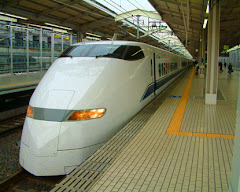'Visionary' rail network linking New Jersey and Pennsylvania regions would imitate passenger train system in Europe
Friday, October 31, 2008
By TONY NAUROTH
The Express-Times
http://www.lehighvalleylive.com/easton/index.ssf?/base/news-0/1225425988210560.xml&coll=3&thispage=1
EASTON An effort to bring rail service to Phillipsburg and Easton keeps chugging along a track that could tie in mid-Atlantic population centers via a network similar to that found in Europe.
Local leaders and passenger rail enthusiasts gathered Thursday morning at Lafayette College's Pfenning Alumni Center to hear about a plan college President Daniel Weiss called "visionary."
Paul Marin, chairman of the Lehigh Valley Economic Development Corp.'s transportation committee, laid out details.
"The key," Marin told the group, "is legislation; the key is political will."
That means marshaling the support of the mayors of the municipalities that would benefit from a rail line as well as state and national elected leaders who can funnel the money into such a project.
"This is not new," said Easton Mayor Sal Panto, "The idea has been around for 25 years. Now we're looking to have it as a reality in five to 10 years."
In his presentation, with the hefty title "Unified Passenger Rail Network for the Mid-Atlantic Region," Marin pointed to a $250,000 study, already approved, that could start in about six weeks to identify the state of tracks and stations along the proposed routes.
Vision beyond the Valley
But the vision Marin described goes beyond the Lehigh Valley.
"People think a rail line would only be for New York City commuters. That's not true.
"The forward edge of (baby boom) empty nesters will reach 2011, and they won't want to live in big homes in cul-de-sacs," he said, adding that people will want to live close to services, close to transportation and close to each other.
They'll have to give up their SUVs and learn to shop locally, not in huge malls accessible only by roads.
"The question we must ask ourselves," Marin said, "is, 'Are we ready for a lifestyle change?' "
For those who say rail service is too expensive, Marin noted the case of Charlotte, N.C. where, in 1999, a 10-mile light rail line was built, drawing people to live in downtowns that had been failing economically.
"They spent $700 million dollars to build it; the economic investment return was $7 billion," said Marin, who also is a board member with the Lehigh and Northampton Transportation Authority.
Building homes and business around rail lines and stations is called transportation-oriented development.
Marin also compared the rail line potential to what Switzerland already has. Using slides of the mid-Atlantic region next to a map of Switzerland, Marin showed that the land areas are similar in size.
Then he showed their respective rail lines with the central European country well-networked, despite its mountainous terrain.
"Fifty million people live within a 50-mile radius of the Lehigh Valley," Marin said. "Switzerland has 7 million people."
"We have a rail system Bolivia would be ashamed of," Marin added.
U.S. Rep. Charlie Dent, R-Lehigh Valley, attended the breakfast presentation and later said he supports a rail network, but noted, "This issue is more about money than anything else."
He said the federal government typically puts 50 percent into transportation projects. The other 50 percent must come from local governments and private contributions.
Dent said he's "very much aware" of the current Lehigh Valley study and says his hope is to link it with one already in progress in New Jersey that would offer suggestions on the feasibility of extending the current rail line from High Bridge to Phillipsburg.
"We're going to piggyback onto the New Jersey study," Dent said. "This is not a Washington-driven phenomena," he said. "It's got to be locally driven."




